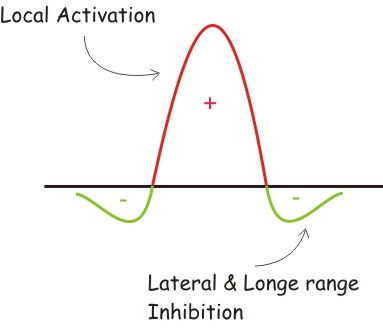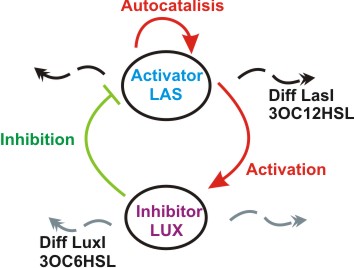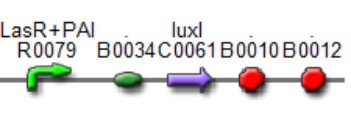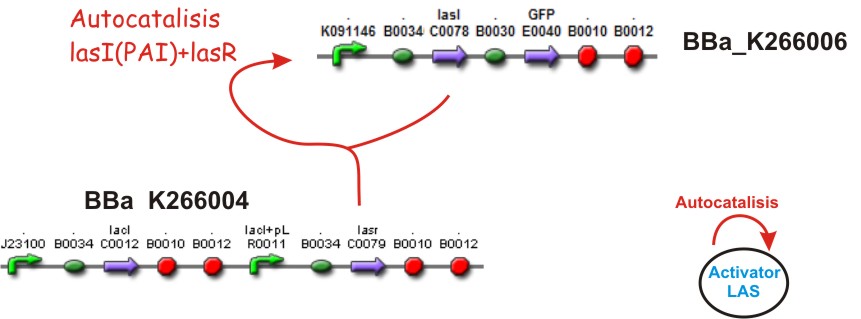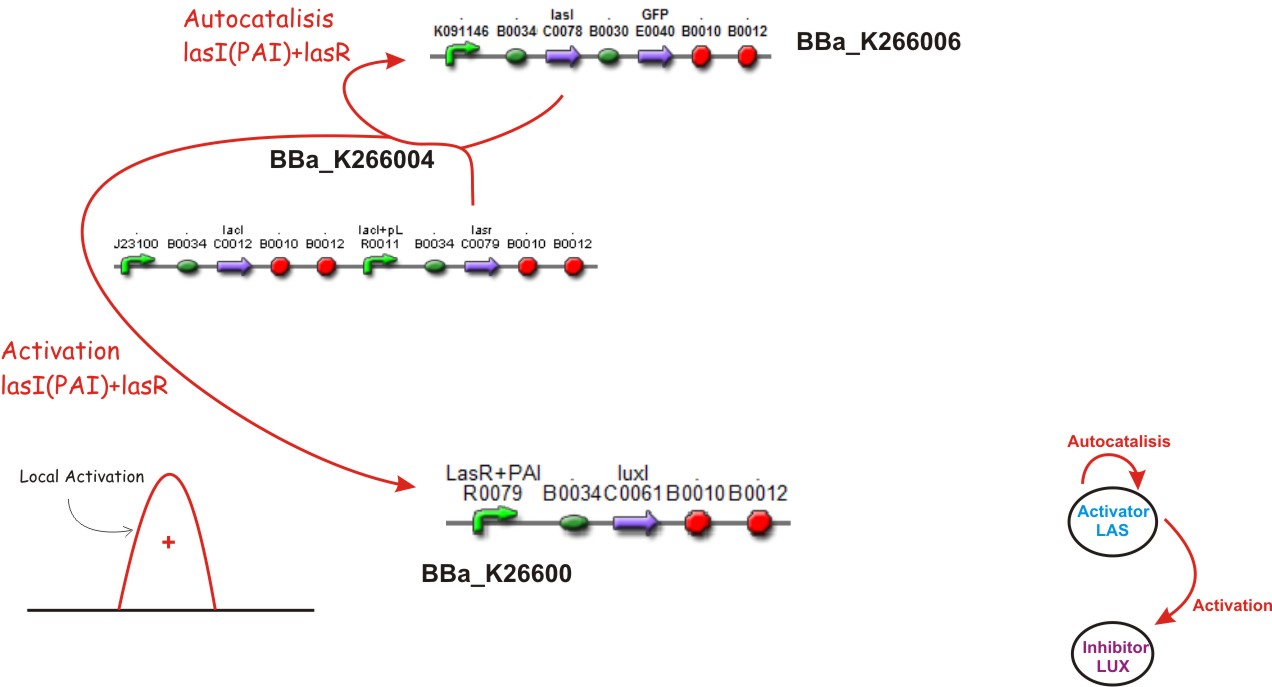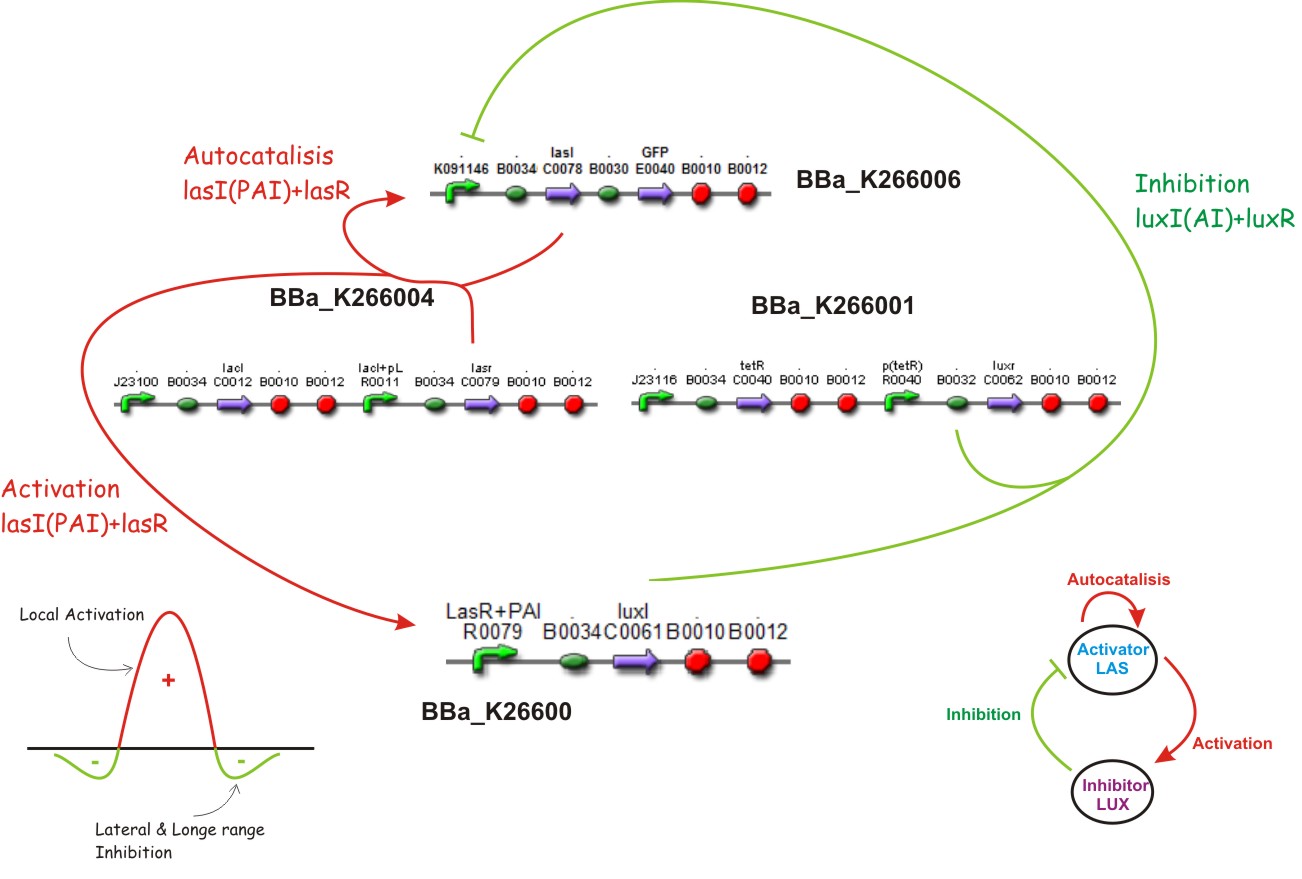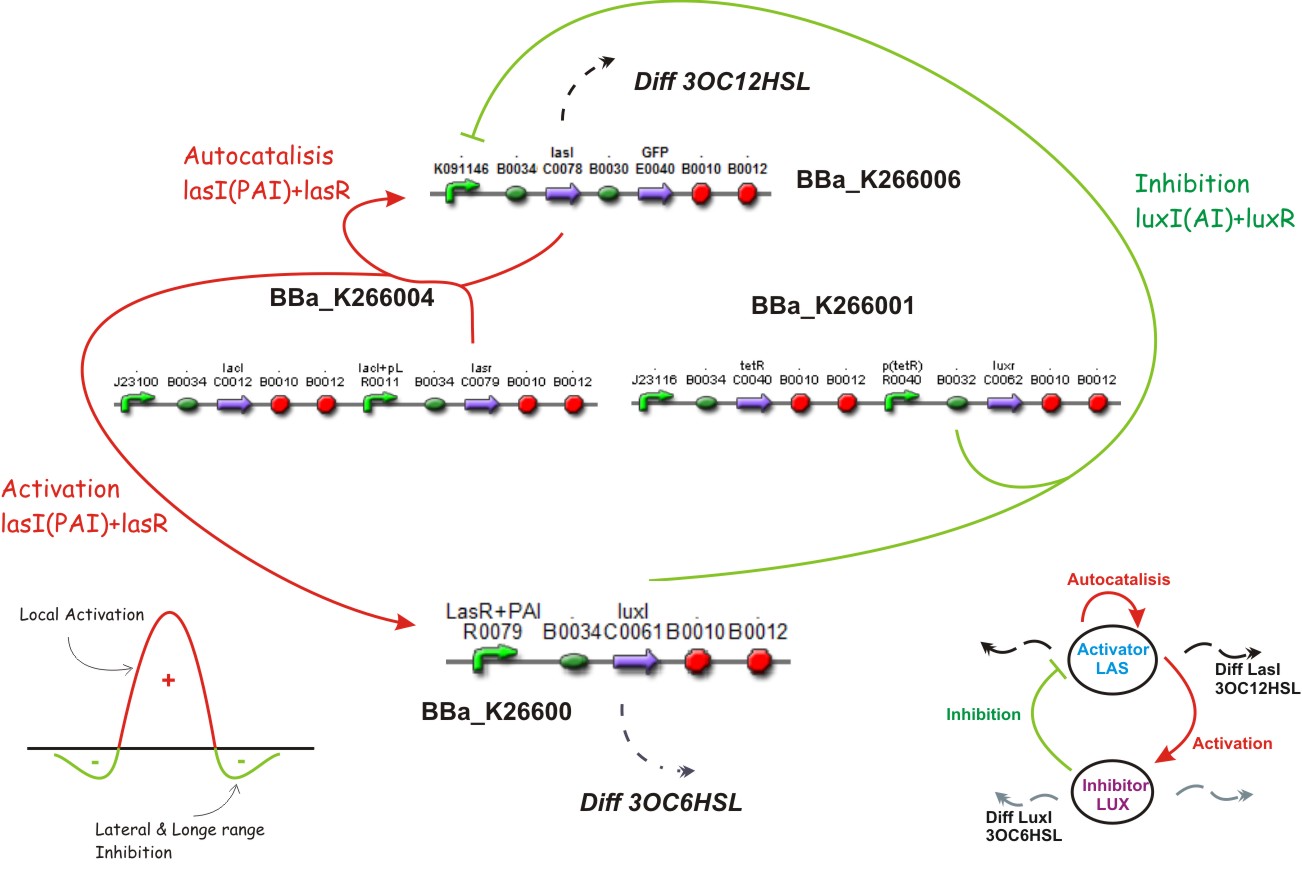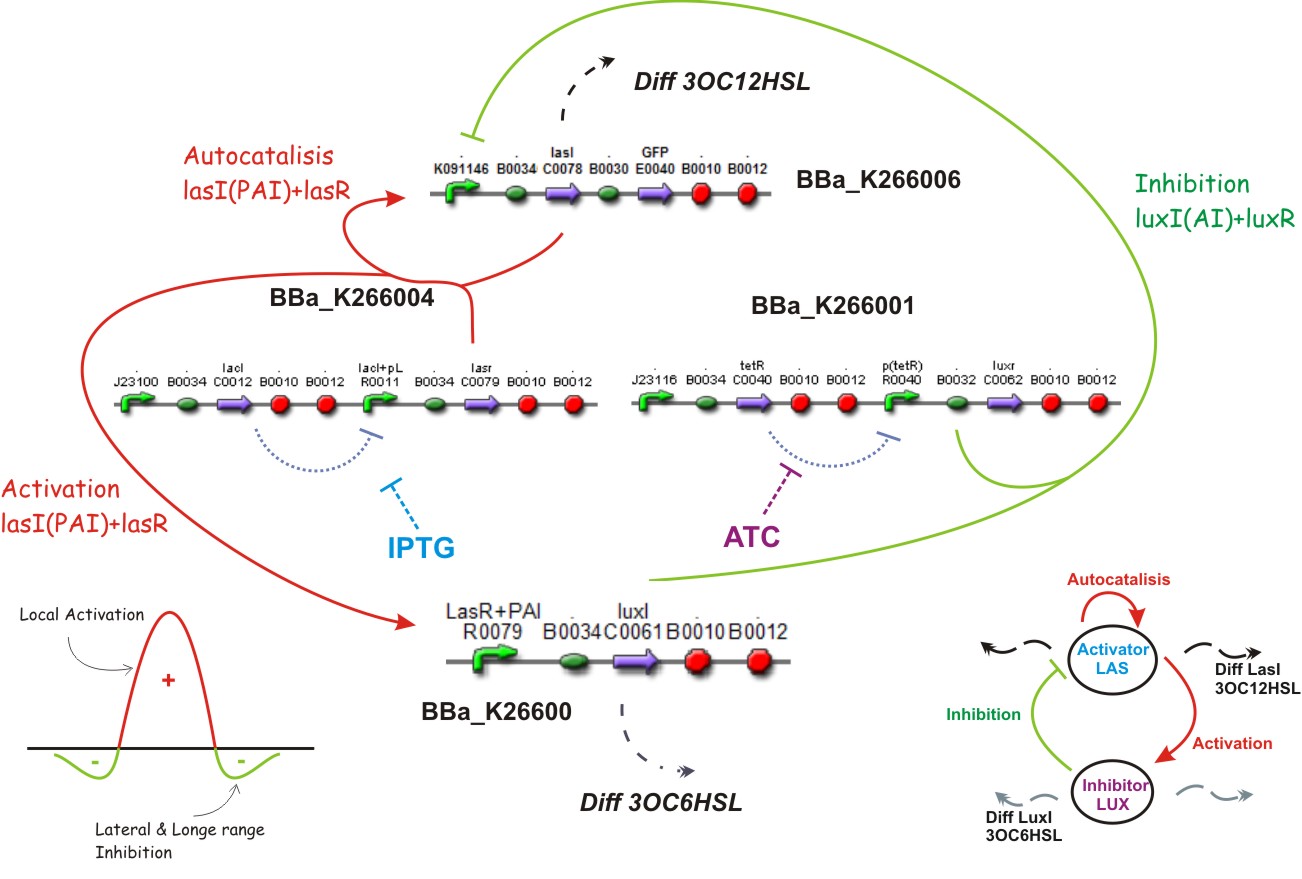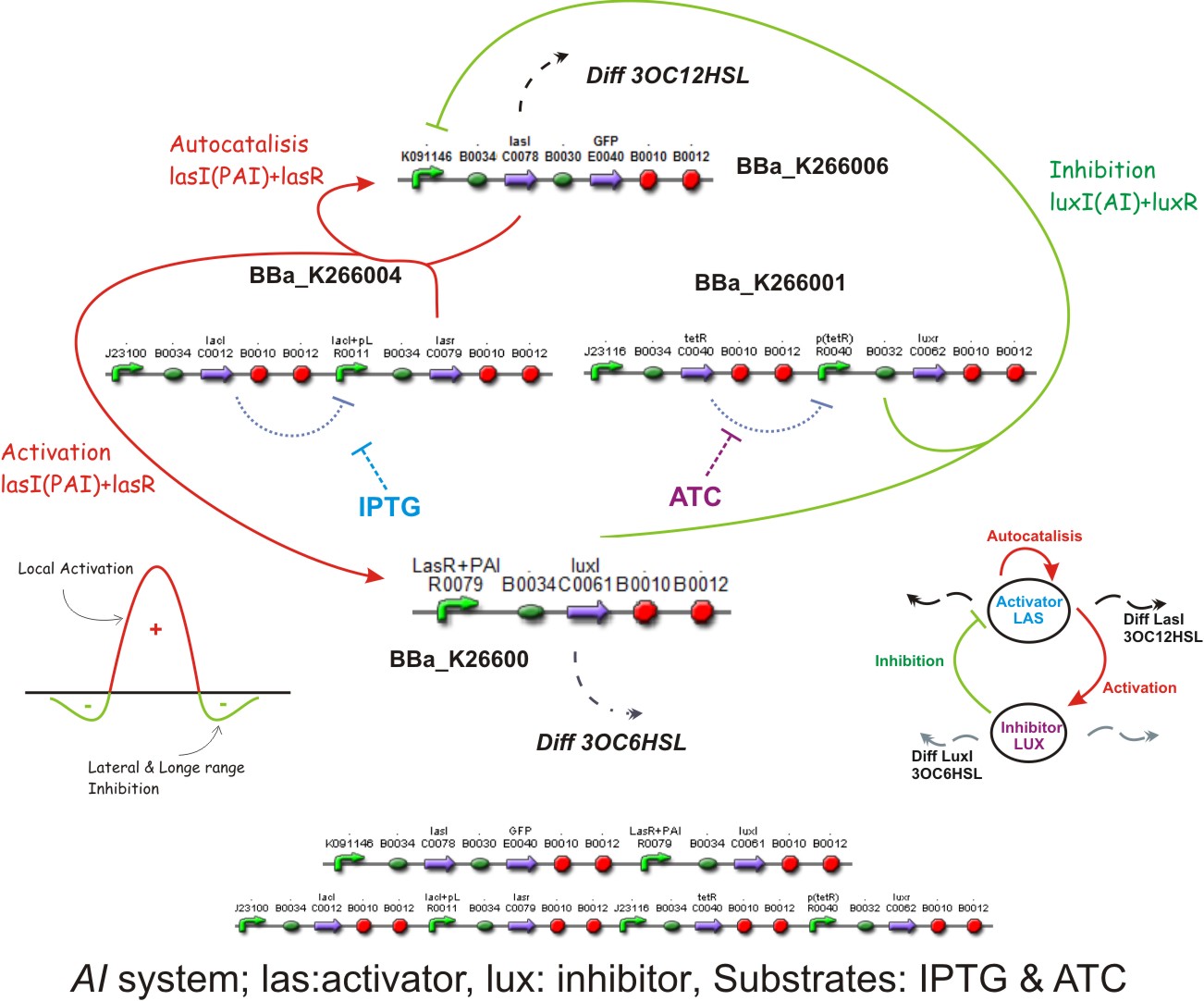Team:IPN-UNAM-Mexico/Project
From 2009.igem.org
m |
(Project first part) |
||
| Line 3: | Line 3: | ||
<center><h1>Turing meets synthetic biology</h1></center> | <center><h1>Turing meets synthetic biology</h1></center> | ||
| + | |||
| + | ==[[Image:Month-icon.png | 50px]]Introduction== | ||
| + | |||
| + | ===The work of Turing=== | ||
| + | |||
| + | In 1952 Alan M. Turing in his classical paper called ''The chemical basis of morphogenesis ''proposed a mechanism for generating coat patterns. This mechanism is amazing by its simplicity. With only two “morphogenes†it’s possible to reproduce nontrivial patterns that are similar to those of zebras or leopards. | ||
| + | |||
| + | Although there is no enough evidence of the existence of these morphogenes in living organisms, the likeliness of the patterns obtained by theoretical means using this model with the ones found in nature is astonishing. | ||
| + | |||
| + | Turing assumed that the morphogenes can react with each other and diffuse through cells. It is necessary that at the beginning there is a non-homogeneous distribuition of these morphogenes, which is often called chemical prepattern. An intuitive notion would tell us that the diffusion of the morphogenes starting from this chemical prepattern would led to a homogenous state of the system, but surprisingly the Turing proposal says that non-homgenous structures will arise, as a direct consequence of diffusion (the turing hyphotesis); reaching a stable state with reagions with high concentrantions of one morphogen and regions with high concentration of others. This non-homogeneous distribuition patterns of morphogenes resembles those found in nature. | ||
| + | |||
| + | |||
| + | ===Reaction-Diffusion equations=== | ||
| + | |||
| + | Turing described formally his proposed with a set of Partial Differential Equations where is possible to represent the chemical interactions of the morphogens and the way they move over the space. This kind of dynamics are commonly called reaction-diffusion mechanisms, and named the equations that described them as Reaction-Diffusion equations. In section modeling (LINK!) we present formaly them. | ||
| + | |||
| + | |||
| + | ===The Activator-Inhibitor=== | ||
| + | |||
| + | In 1972 A. Gierer and H. Meinhardt published his work called ''A theory of biological pattern formation'' and presented a network based in the interaction of at least two morphogenes that acts as an activator and an inhibitor. The main qualitative dynamics of the morphogens is: | ||
| + | |||
| + | ''“Short range activation, longer range inhibition and a conceptual distinction between effective concentrations of activator and inhibitor, on one hand, and the density of their sources on the other.â€'' | ||
| + | |||
| + | Schematically we can see this description as: | ||
| + | |||
| + | IMAGEN | ||
| + | |||
| + | |||
| + | <nowiki>J. D Murray in [REF] presented a good example of how patterns can arise from this kind of dynamics and cited them literally:</nowiki> | ||
| + | |||
| + | <center>''Consider a field of dry grass in which there is a large number of grasshoppers''</center> | ||
| + | |||
| + | <center>''which can generate a lot of moisture by sweating if they get warm. Now suppose the''</center> | ||
| + | |||
| + | <center>''grass is set alight at some point and a flame front starts to propagate. We can think of''</center> | ||
| + | |||
| + | <center>''the grasshopper as an inhibitor and the fire as an activator. If there were no moisture''</center> | ||
| + | |||
| + | <center>''to quench the flames the fire would simply spread over the whole field which would''</center> | ||
| + | |||
| + | <center>''result in a uniform charred area. Suppose, however, that when the grasshoppers get''</center> | ||
| + | |||
| + | <center>''warm enough they can generate enough moisture to dampen the grass so that when the''</center> | ||
| + | |||
| + | <center>''flames reach such a pre-moistened area the grass will not burn. The scenario for spatial''</center> | ||
| + | |||
| + | <center>''pattern is then as follows. The fire starts to spread it is one of the reactants, the''</center> | ||
| + | |||
| + | <center>''activator, with a diffusion coefficient DF say. When the grasshoppers, the inhibitor''</center> | ||
| + | |||
| + | <center>''reactant, ahead of the flame front feel it coming they move quickly well ahead of''</center> | ||
| + | |||
| + | <center>''it; that is, they have a diffusion coefficient, DG say, which is much larger than DF .''</center> | ||
| + | |||
| + | <center>''The grasshoppers then sweat profusely and generate enough moisture to prevent the''</center> | ||
| + | |||
| + | <center>''fire spreading into the moistened area. In this way the charred area is restricted to a''</center> | ||
| + | |||
| + | <center>''finite domain which depends on the diffusion coefficients of the reactants fire and''</center> | ||
| + | |||
| + | <center>''grasshopperand various reaction parameters. If, instead of a single initial fire, there''</center> | ||
| + | |||
| + | <center>''were a random scattering of them we can see how this process would result in a final''</center> | ||
| + | |||
| + | <center>''spatially heterogeneous steady state distribution of charred and uncharred regions in''</center> | ||
| + | |||
| + | <center>''the field and a spatial distribution of grasshoppers, since around each fire the above''</center> | ||
| + | |||
| + | <center>''scenario would take place. If the grasshoppers and flame front diffused at the same''</center> | ||
| + | |||
| + | <center>''speed no such spatial pattern could evolve.''</center> | ||
| + | |||
| + | |||
| + | We can now represent the interactions between the activator and the inhibitor as: | ||
| + | |||
| + | The activator is autocathalyzed and it also activates the formation of the inhibitor. Accordingly to its name, the inhibitor inhibits the production of the activator, leading to a simple but very rich dymamics (For more details on the acivator-inhibitor equations please Modeling section). From the grass field and the fire analogy we can deduce that the diffusion coefficients of the fire should be slower than the grasshppers one; if not the fire (activator) would spread completely in the area. This is an important fact that we mention again later. | ||
| + | |||
| + | |||
| + | ==='''GENERAL CONDITIONS FOR PATTERN GENERATION'''=== | ||
| + | |||
| + | Although this kind of conditions refers mainly to a mathematical analyses of the reaction-diffusion systems like the Activator-Inhibitor (check MURRAY REF), we can qualitative simplify and establish according to this analyses the general conditions for pattern formation: | ||
| + | |||
| + | |||
| + | # The existence of at least of two morphogenes with different nature that interacts chemically between them diffuse over the space | ||
| + | # The coefficient rates of diffusion should be different. | ||
| + | # The starting distribution of morphogenes should not be completely homogeneous over the space. | ||
| + | # The Gierer and Mainhardt proposal: local activation and longe range inhibition. | ||
Revision as of 18:34, 21 October 2009
Turing meets synthetic biology
 Introduction
Introduction
The work of Turing
In 1952 Alan M. Turing in his classical paper called The chemical basis of morphogenesis proposed a mechanism for generating coat patterns. This mechanism is amazing by its simplicity. With only two “morphogenes†it’s possible to reproduce nontrivial patterns that are similar to those of zebras or leopards.
Although there is no enough evidence of the existence of these morphogenes in living organisms, the likeliness of the patterns obtained by theoretical means using this model with the ones found in nature is astonishing.
Turing assumed that the morphogenes can react with each other and diffuse through cells. It is necessary that at the beginning there is a non-homogeneous distribuition of these morphogenes, which is often called chemical prepattern. An intuitive notion would tell us that the diffusion of the morphogenes starting from this chemical prepattern would led to a homogenous state of the system, but surprisingly the Turing proposal says that non-homgenous structures will arise, as a direct consequence of diffusion (the turing hyphotesis); reaching a stable state with reagions with high concentrantions of one morphogen and regions with high concentration of others. This non-homogeneous distribuition patterns of morphogenes resembles those found in nature.
Reaction-Diffusion equations
Turing described formally his proposed with a set of Partial Differential Equations where is possible to represent the chemical interactions of the morphogens and the way they move over the space. This kind of dynamics are commonly called reaction-diffusion mechanisms, and named the equations that described them as Reaction-Diffusion equations. In section modeling (LINK!) we present formaly them.
The Activator-Inhibitor
In 1972 A. Gierer and H. Meinhardt published his work called A theory of biological pattern formation and presented a network based in the interaction of at least two morphogenes that acts as an activator and an inhibitor. The main qualitative dynamics of the morphogens is:
“Short range activation, longer range inhibition and a conceptual distinction between effective concentrations of activator and inhibitor, on one hand, and the density of their sources on the other.â€
Schematically we can see this description as:
IMAGEN
J. D Murray in [REF] presented a good example of how patterns can arise from this kind of dynamics and cited them literally:
We can now represent the interactions between the activator and the inhibitor as:
The activator is autocathalyzed and it also activates the formation of the inhibitor. Accordingly to its name, the inhibitor inhibits the production of the activator, leading to a simple but very rich dymamics (For more details on the acivator-inhibitor equations please Modeling section). From the grass field and the fire analogy we can deduce that the diffusion coefficients of the fire should be slower than the grasshppers one; if not the fire (activator) would spread completely in the area. This is an important fact that we mention again later.
GENERAL CONDITIONS FOR PATTERN GENERATION
Although this kind of conditions refers mainly to a mathematical analyses of the reaction-diffusion systems like the Activator-Inhibitor (check MURRAY REF), we can qualitative simplify and establish according to this analyses the general conditions for pattern formation:
- The existence of at least of two morphogenes with different nature that interacts chemically between them diffuse over the space
- The coefficient rates of diffusion should be different.
- The starting distribution of morphogenes should not be completely homogeneous over the space.
- The Gierer and Mainhardt proposal: local activation and longe range inhibition.
 Morphogenesis qualitative mechanisms
Morphogenesis qualitative mechanisms
 Reaction-Diffusion systems implemented on Biobricks
Reaction-Diffusion systems implemented on Biobricks
Reaction
Diffusion
Substrates
[http://openwetware.org/wiki/IPTG IPTG] & [http://openwetware.org/wiki/ATc ATC]
 The Activator-Inhibitor system on biobricks: The dynamics
The Activator-Inhibitor system on biobricks: The dynamics
Autocatalisis
Activation
Inhibition
Diffusion
Substrates
Complete system





 "
"

